Lifestyle
Unlock Your Best Tan With Smart Sessions
Incorporate tailored tanning sessions to enhance your glow and discover secrets for maintaining a radiant tan that lasts!

You can access your best tan by tailoring your sessions to your skin type. Start with short sessions and gradually increase their length, keeping in mind that fair skin needs fewer visits than darker tones. Preparing your skin is essential: exfoliate 24 hours prior and hydrate well. After tanning, moisturize immediately to keep your glow vibrant. Aim for regular sessions, but know when to ease back to maintain your color effectively. By understanding your skin and following these steps, you'll achieve a radiant tan. There's more to explore on enhancing your tanning experience and keeping it fresh!
Key Takeaways
- Assess your skin type using the Fitzpatrick Scale to determine optimal tanning frequency for best results.
- Prepare your skin by exfoliating 24 hours prior and arriving makeup-free for even product application.
- Start with short tanning sessions to gauge your skin's response, gradually increasing duration as needed.
- Maintain hydration by drinking water and using a moisturizer before and after tanning to enhance results.
Understanding Your Skin Type
To reveal your best tan, start by identifying your skin type using the Fitzpatrick Scale, which helps you tailor your tanning strategy effectively. This scale categorizes skin into six types based on how easily it burns and tans.
If you have fair skin, you'll want to begin with brief sessions to establish a base tan, while medium skin types can handle slightly longer sessions. Olive skin types can enjoy more frequent sessions, but even darker skin must exercise caution.
Follow the recommended frequencies: fair (1-2 times a week), medium (2-3), olive (3-4), and darker (4-5). Adjust your session duration as your skin adapts to guarantee ideal results without overexposure.
Preparing for Your Session
Exfoliating your skin 24 hours before your tanning session helps eliminate dead skin cells, ensuring a smooth and even tan.
After exfoliation, it's essential to hydrate your skin adequately; dry skin doesn't tan well. Make sure to moisturize regularly leading up to your session to keep your skin in ideal condition.
When you arrive for your tanning session, come with clean, makeup-free skin. This allows for an even application of the tanning product or UV rays.
Avoid using any lotions or oils that might interfere with the tanning process. By following these simple steps, you'll set the stage for achieving that beautiful, bronzed glow you desire.
Preparing properly maximizes your results and enhances your tanning experience.
Managing Tanning Sessions

Managing your tanning sessions effectively is essential for achieving a deep and even tan while minimizing the risk of skin damage.
Start with short sessions to gauge your skin's response, gradually increasing the duration as your skin adapts. Aim for a balanced schedule—limit yourself to one session per day.
For initial color development, you might need 3-5 sessions, especially if you have lighter skin. Once you've reached your desired shade, cut back to 2 sessions weekly for maintenance.
Consider alternating tanning beds to benefit from different wavelengths, promoting an even tan and preventing overexposure in certain areas.
Always listen to your skin and adjust your routine as needed to keep it healthy and glowing.
Post-Tanning Care
Applying moisturizer immediately after tanning helps prevent peeling and keeps your skin hydrated.
To maintain that gorgeous glow, incorporate these essential post-tanning care tips into your routine:
- Use a professional tan extender to prolong your tan and enhance its vibrancy.
- Stay hydrated by drinking plenty of water; it's vital for keeping your skin looking its best.
- Avoid hot showers or baths for the first 24 hours post-tan to preserve your color.
Health and Safety Tips

Understanding your skin's limits is essential to enjoying a safe and effective tanning experience. Always start with short tanning sessions to gauge how your skin reacts.
If you have fair skin, limit your sessions to 1-2 times a week, while darker skin types can go up to 4-5 times. Hydration is key—drink plenty of water and use a good moisturizer before and after tanning.
Rotate your position during sessions to avoid uneven tan lines. Keep an eye on your skin; if you notice any irritation or redness, give it a break.
Above all, patience is crucial; gradual exposure leads to the best results without damaging your skin. Stay informed about safety practices for a healthier tanning experience.
Frequently Asked Questions
How Can I Tell if a Tanning Bed Is Safe?
To determine if a tanning bed's safe, check for recent certifications, guarantee it's well-maintained, and confirm the bulbs are functioning properly. You should also read reviews and ask staff about their safety practices.
What Are the Signs of Overexposure to UV Rays?
Signs of overexposure to UV rays include redness, swelling, blistering, and peeling skin. You might also experience discomfort, fever, or chills. If you notice these symptoms, it's essential to minimize further sun exposure immediately.
Can I Tan if I Have a Skin Condition?
You can tan with a skin condition, but it's essential to consult your dermatologist first. They'll help you understand any risks and recommend safe tanning practices tailored to your specific needs. Stay cautious!
How Long Does a Tan Typically Last?
A tan typically lasts about 7 to 10 days, depending on your skin type and care. Moisturizing and exfoliating can help extend its life, while sun exposure can fade it more quickly.
Are There Any Foods That Enhance Tanning Results?
Eating foods rich in carotenoids, like carrots, can enhance your tan. For instance, when you add these to your diet, you might notice a deeper, more golden hue in your skin after tanning sessions.
Conclusion
As you bask in the sun's warm embrace, remember that your journey to the perfect tan is a blend of care and knowledge.
With your skin glowing like golden sand, you'll revel in the beauty of your hard work.
Embrace each session, savoring the gentle warmth that deepens your hue, and don't forget to nourish your skin afterward.
With every step, you're not just tanning; you're crafting a radiant, sun-kissed masterpiece that shines with confidence.
Lifestyle
Why Some Foods Taste Better When Eaten at Specific Altitudes
You might be surprised to learn how altitude alters your taste perception and why chefs adapt meals to enhance your dining experience.
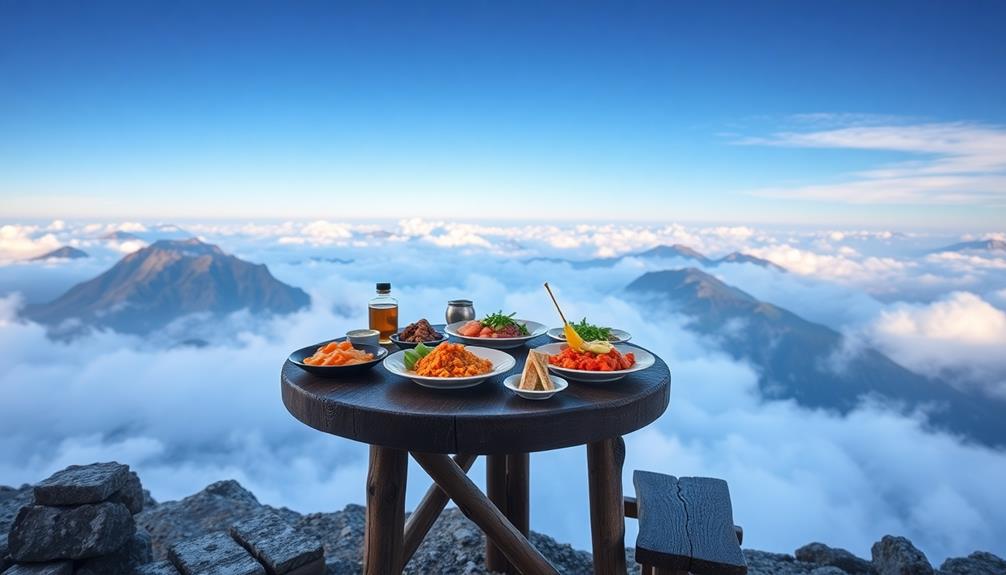
Foods taste different at specific altitudes primarily because your taste perception changes. At high altitudes, lower oxygen levels and reduced atmospheric pressure can decrease your ability to taste, leading to about a 30% drop in flavor sensitivity. Sweet and salty flavors are hit the hardest, making meals less enjoyable. To compensate, chefs often enhance dishes with increased salt and sugar, especially in airline meals. Additionally, your familiarity with high altitude can improve your taste experience. Want to discover more about how altitude affects flavor and how chefs adapt meals for your enjoyment?
Key Takeaways
- Taste perception decreases at high altitudes, making certain foods with enhanced flavors more enjoyable.
- Sweet and salty flavors are less effective at altitude, while umami and sour flavors remain stable.
- Increased salt and sugar in meals can compensate for diminished taste sensitivity at high altitudes.
- Familiarity with altitude can enhance taste experiences, making some foods more appealing.
- Innovative culinary adaptations, such as collaborations with chefs, improve in-flight dining flavors.
Effects of Altitude on Taste

As you ascend to higher altitudes, you may notice that your sense of taste takes a hit. Research shows that at high altitudes, your taste perception can decrease by about 30%. Changes in atmospheric pressure and reduced oxygen levels play a big role in this decline. Sweet and salty flavors often suffer the most, leaving you with a less satisfying meal.
However, sour tastes tend to remain stable, while bitter flavors may even intensify. Curiously, foods with rich umami flavors, like ankimo (monkfish liver pâté), can provide a more enjoyable experience at high altitudes due to their depth of taste.
The dry air at high altitudes further complicates things, as it diminishes your sense of smell, which accounts for roughly 80% of your taste experience. This combination can really affect how you enjoy food. For example, coffee aromas and tomato juice flavors are significantly altered in high-altitude environments, making them less appealing.
Remarkably, the more time you spend at high altitudes, the more your taste perception can adapt. Familiarity with these conditions can enhance your overall taste experience, allowing you to enjoy food in ways you mightn't have expected.
Understanding these effects can help you choose meals that suit your palate when you find yourself at great heights.
Airline Menu Adaptations
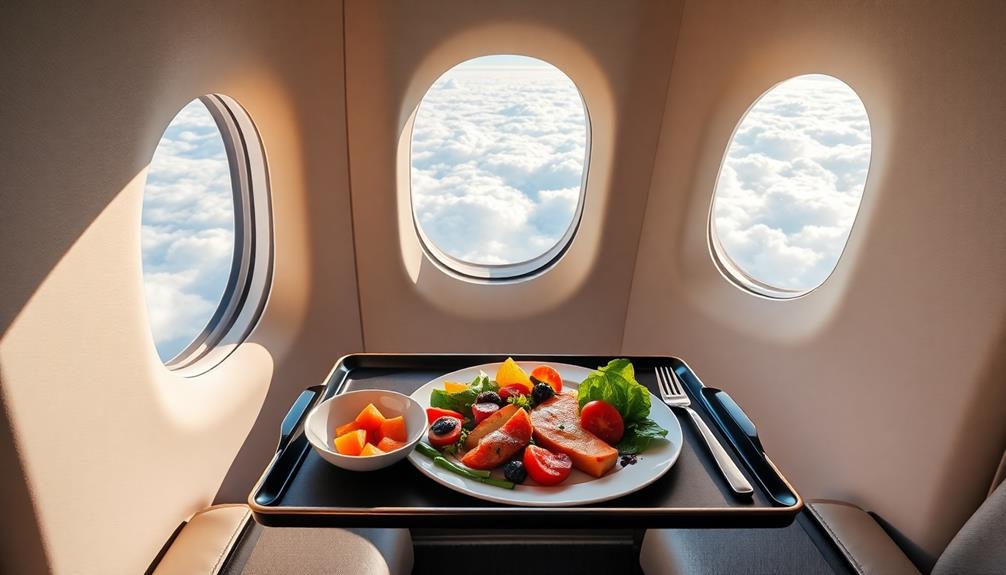
Airline menus are carefully crafted to enhance your dining experience at high altitudes, where taste perception diminishes considerably. Traditional dishes like Red-Braised Pork Belly are often adapted to retain their rich flavors in the air.
Airline chefs, like those for British Airways, account for these effects by adjusting their recipes. They often increase salt and sugar to boost flavors while keeping hydration in mind. Studies show that your sense of taste drops by about 30% during flights, which is why umami flavors become vital. This has led airlines to incorporate umami-rich ingredients to elevate meal options.
JetBlue collaborates with restaurant Saxon+Parole to create dishes that emphasize acidity, heat, and umami, ensuring that your in-flight meals remain flavorful.
British Airways has also recognized the need for specialized meals with enhanced flavor profiles. They focus on ingredients that cater to your taste buds at high altitudes, making your experience more enjoyable.
Continuous research into how altitude impacts taste perception motivates these culinary strategies, allowing airlines to refine their menus. By understanding the science behind your dining experience, airlines aim to enhance passenger satisfaction during flights, ensuring you savor every bite, even at cruising altitude.
Innovative Culinary Collaborations

Innovative culinary collaborations are transforming in-flight dining by addressing the unique challenges posed by high altitudes. Airlines like JetBlue and British Airways are teaming up with celebrated chefs to enhance your dining experience.
For example, JetBlue partners with Saxon+Parole, focusing on balancing acidity, heat, and umami flavors to cater to your diminished sense of taste at high elevations. This approach is similar to how Brazilian dishes like Caldeirada utilize rich flavors and diverse ingredients to create a satisfying experience.
Chef Brad Farmerie creatively uses ingredients like chili marshmallows in carrot and ginger soup to keep flavors vibrant without relying on excessive salt.
British Airways collaborates with Heston Blumenthal to explore ingredient perception, ensuring that the food you enjoy in the sky remains flavorful despite altitude's effects.
Lufthansa's partnership with the Fraunhofer Institute brings a scientific approach to identifying ideal food pairings, enriching the flavor profiles of meals served during flights.
These innovative culinary approaches are essential for developing meals that remain enjoyable for you at high altitudes. By emphasizing umami flavors and carefully selecting spices, airlines are reshaping your in-flight dining experience, making it more satisfying and memorable.
As these collaborations grow, your taste buds will thank you for the elevated dining experiences.
Specialized Beverage Offerings

How can specialized beverages elevate your in-flight experience? Airlines are now focusing on crafting drinks that enhance your enjoyment of food at high altitudes.
For instance, British Airways teamed up with Brewdog to create Speedbird 100 beer, specifically brewed to boost flavor perception while you're soaring through the skies. Similarly, Cathay Pacific offers a unique beer, designed with special ingredients that perform better in the cabin environment.
Wines from high-altitude regions also stand out, as they often maintain their flavor integrity during flights, enhancing your overall dining experience.
You'll find that the taste of food is greatly influenced by your sense of smell, which can be diminished in the cabin. That's why airlines are continuously adapting their beverage selections, ensuring you have options that are appealing and enjoyable at cruising altitudes.
While champagne is a classic choice, it tends to lose its fizz quickly due to cabin pressure, affecting the overall drinking experience.
Choosing specialized beverages can make a significant difference, allowing you to savor every bite and sip, ultimately transforming your journey into a delightful culinary adventure.
Challenges in Flavor Enhancement
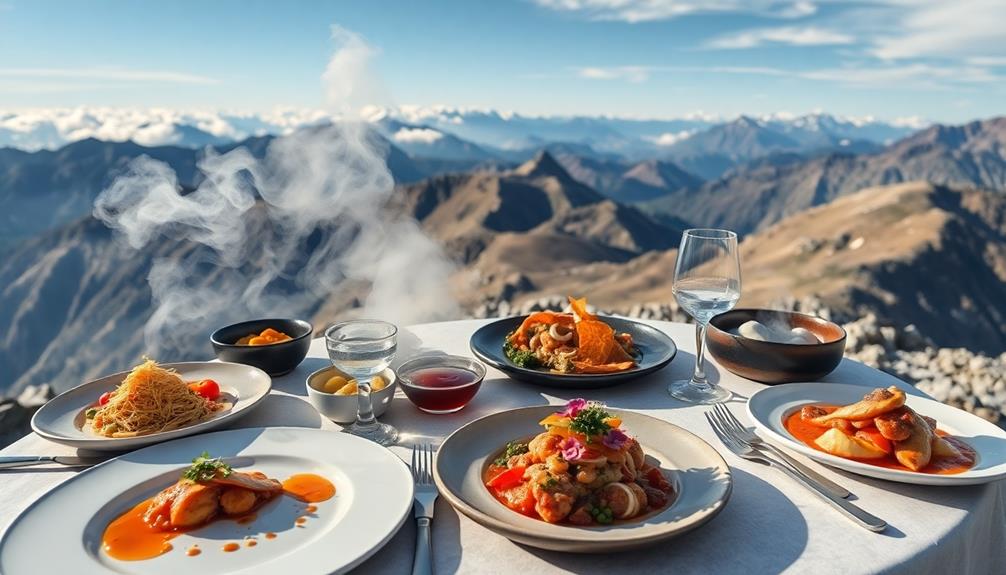
Steering through the challenges of flavor enhancement at high altitudes requires a thoughtful approach from culinary teams. Airlines, like British Airways, face the difficult task of making meals taste different while considering passenger hydration.
At high altitudes, increased salt and sugar can lead to dehydration, forcing chefs to balance flavor without compromising wellness.
Unfortunately, there aren't any formal recipes designed specifically for in-flight meals, which complicates the process. Culinary teams must also cater to a variety of dietary restrictions and preferences, making it even tougher to create universally appealing menus.
The diminished taste sensitivity you experience at altitude means that typical flavor profiles may not register as intended. This calls for innovative menu planning strategies that enhance flavor without overwhelming the palate.
Continuous research is essential to understand how altitude impacts flavor perception, providing the necessary insights to improve your in-flight dining experience.
Ultimately, the challenge lies in crafting meals that remain enjoyable and memorable, ensuring that each bite resonates even when you're miles above the ground.
Frequently Asked Questions
Why Does Food Taste Different at Different Altitudes?
Food tastes different at various altitudes because changes in atmospheric pressure affect your taste buds and sense of smell. You might find certain flavors less intense, while others, like bitterness, can become more pronounced.
Does Food Cook Differently at High Altitude?
Yes, food cooks differently at high altitudes. You'll notice longer cooking times and adjustments needed for recipes. Lower boiling temperatures affect textures, and you might need to modify ingredients to achieve the desired results.
What Foods Are Good to Eat at High Altitude?
When you're at high altitude, opt for hydrating foods like soups and stews. Nutrient-dense snacks, such as trail mix and energy bars, keep your energy up. Enjoy fruits for their enhanced sweetness; they'll taste amazing!
Why Does Food Taste Different in the Sky?
When you eat in the sky, lower pressure and humidity affect your taste buds. You'll notice flavors shift; sweet and salty might fade, while umami could pop, altering your overall dining experience during flights.
Conclusion
To wrap it up, eating at higher altitudes transforms flavors in ways you wouldn't believe! The reduced pressure and humidity can dull your taste buds, making some foods taste bland. Airlines have adapted their menus to combat this, collaborating with chefs to enhance flavors. Plus, specialized beverages can elevate your experience even more. So, next time you're soaring through the skies, remember that altitude can turn your meal into a culinary adventure that's nothing short of extraordinary!
Lifestyle
How Cultural Diaspora Shapes Fusion Cuisine Trends
Savor the intriguing ways cultural diaspora influences fusion cuisine trends, as new flavors emerge and redefine our culinary landscape—discover what’s next!
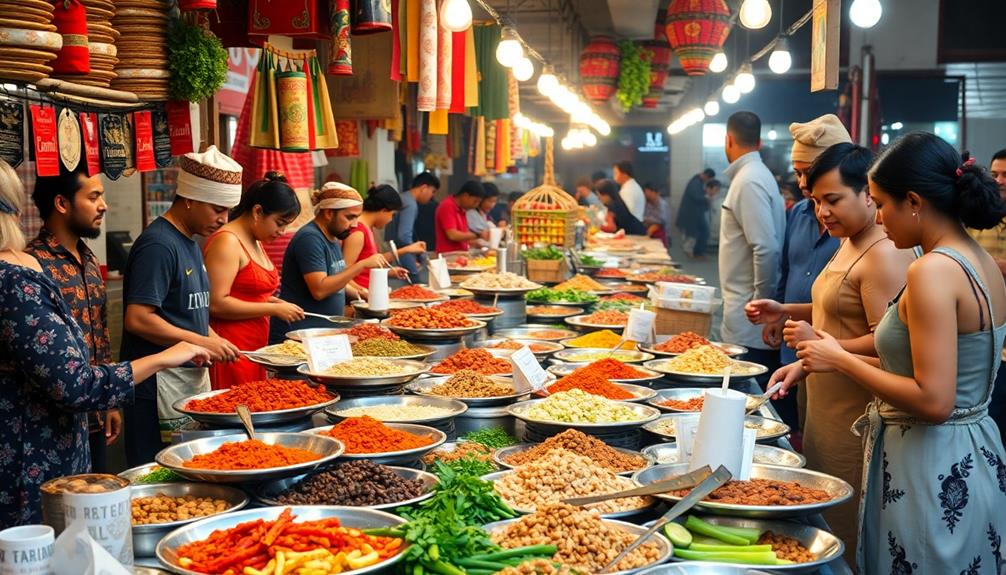
Cultural diaspora shapes fusion cuisine by blending diverse culinary techniques and ingredients, creating unique dining experiences. As people migrate, they bring their flavors, enriching local cuisines with new tastes. You might notice dishes like Korean tacos or sushi burritos that reflect this vibrant interplay of cultures. Chefs often experiment with combining traditional recipes and contemporary techniques, appealing to adventurous diners craving innovative flavors. Plus, the rise of food trucks and pop-up restaurants encourages this culinary creativity. If you're curious about how these trends continue to evolve, you'll find even more exciting insights about the future of fusion cuisine.
Key Takeaways
- Cultural diaspora facilitates the introduction of diverse culinary techniques and ingredients, enriching local cuisines through cross-cultural exchanges.
- Immigrants adapt traditional recipes, leading to innovative dishes that reflect blended culinary traditions and local tastes.
- Ethnic restaurants serve as cultural ambassadors, promoting heritage and fostering appreciation for global flavors within host countries.
- Globalization enhances accessibility to international ingredients, encouraging experimentation and creativity in fusion cuisine.
- Sustainability trends drive the use of local ingredients and responsible cooking practices, reflecting environmental awareness in culinary innovations.
Cultural Diffusion Explained
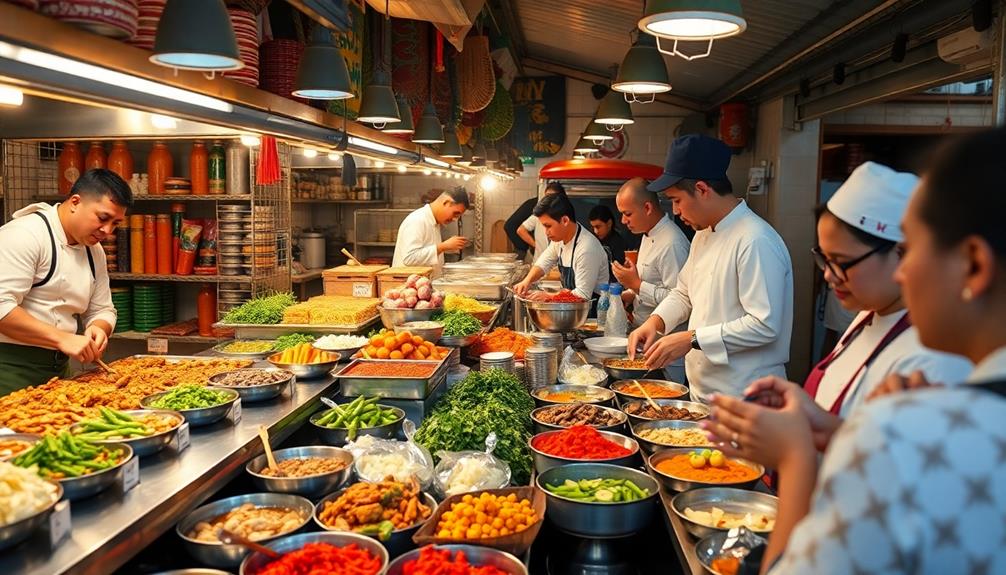
Cultural diffusion plays an essential role in shaping the culinary landscape we enjoy today. This process involves the spread of cultural beliefs and practices, primarily through trade, migration, and conquest, which influences global cuisine.
You might notice how fusion cuisine blends culinary traditions, creating innovative dishes that highlight flavors from different cultures. For instance, Indo-Chinese and Tex-Mex are perfect examples of how diverse culinary practices can merge. Brazilian cuisine also exemplifies this blend, showcasing regional variations that reflect the country's rich cultural tapestry.
Consider the historical spice trade, where spices from India transformed European culinary practices, broadening their flavor profiles. This cultural exchange didn't just stop there; today, you can find creative dishes like the sushi burrito, combining traditional recipes with local ingredients.
This ongoing cultural diffusion continues to shape food culture, allowing you to explore new cooking techniques and diverse flavors.
Fusion Cuisine Evolution
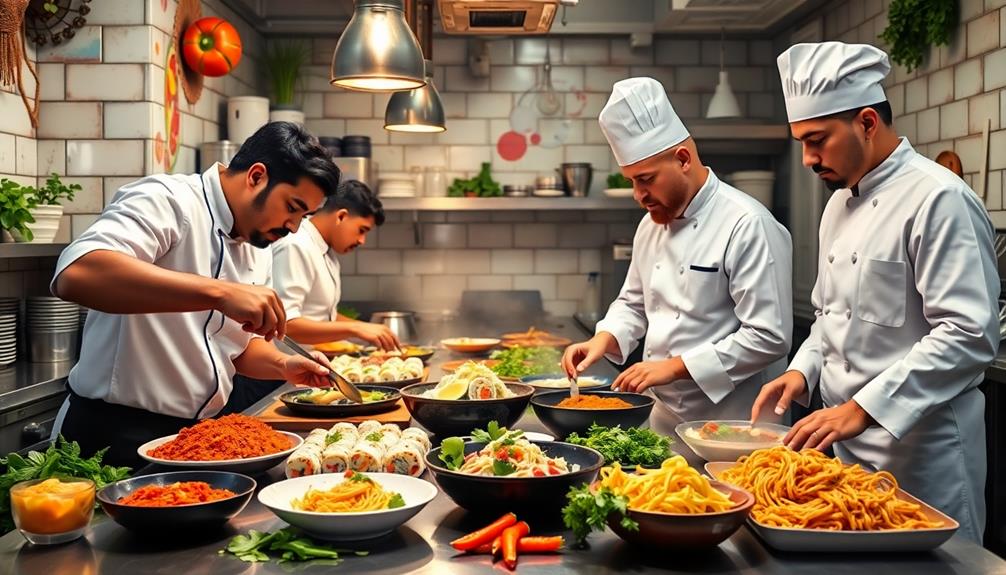
The evolution of fusion cuisine reflects the dynamic interplay of cultures in the culinary world. Since the 1980s, chefs like Wolfgang Puck and Roy Yamaguchi have blended culinary traditions, giving rise to terms like Pan-Asian and Cal-Asian. This cultural diffusion has allowed innovative dishes such as Korean tacos and Japanese-Peruvian ceviche to emerge, showcasing diverse flavor profiles shaped by immigrant populations.
As globalization continues to intertwine food cultures, culinary creativity flourishes. Younger diners are particularly drawn to fusion cuisine, seeking unique dining experiences that challenge conventional boundaries. Food trucks and casual dining spots are at the forefront of this movement, experimenting with daring combinations that reflect a more accepting attitude toward culinary innovation.
Here's a quick look at the key elements driving the evolution of fusion cuisine:
| Aspect | Description |
|---|---|
| Cultural Influences | Blending of diverse culinary traditions |
| Innovative Dishes | Creation of new, hybrid dishes |
| Immigrant Populations | Impact of diverse communities on culinary trends |
| Globalization | Increased accessibility to global ingredients |
| Dining Experiences | Adventurous and unique dining options |
As fusion cuisine evolves, it promises to remain a crucial part of our culinary landscape.
Influences of Migration
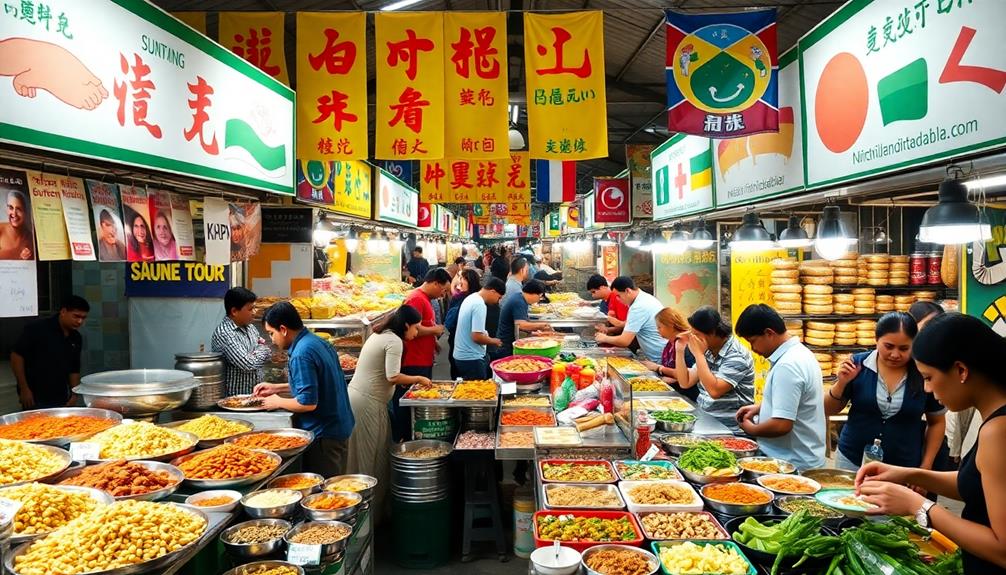
Migration reshapes culinary landscapes by introducing new ingredients and cooking methods to host countries. For instance, traditional Indonesian desserts like Kue Putu and Dadar Gulung reflect the rich flavors that immigrant communities bring to their new homes.
As communities blend, you'll see how culinary traditions evolve, giving rise to exciting fusion cuisine. This transformation often leads to innovative dishes that reflect a mix of cultural heritage.
Here are three key influences of migration on food trends:
- Diverse Ingredients: Immigrants bring local ingredients from their home countries, enriching the culinary scene and inspiring chefs to experiment with flavors.
- Culinary Mashups: Unique combinations like Korean-Mexican tacos or Japanese-Peruvian ceviche showcase how cultural interactions inspire creativity in cooking.
- Ethnic Restaurants as Cultural Ambassadors: These establishments not only serve traditional dishes but also adapt recipes to local tastes, creating a bridge between communities.
Through migration, culinary practices expand, allowing you to savor dishes that celebrate both heritage and innovation.
As you explore these fusion cuisines, you'll discover how migrant communities shape food trends, bringing new life to local dining experiences. The result is a vibrant tapestry of flavors, reflecting the dynamic nature of our ever-evolving global food landscape.
Indian Diaspora Contributions
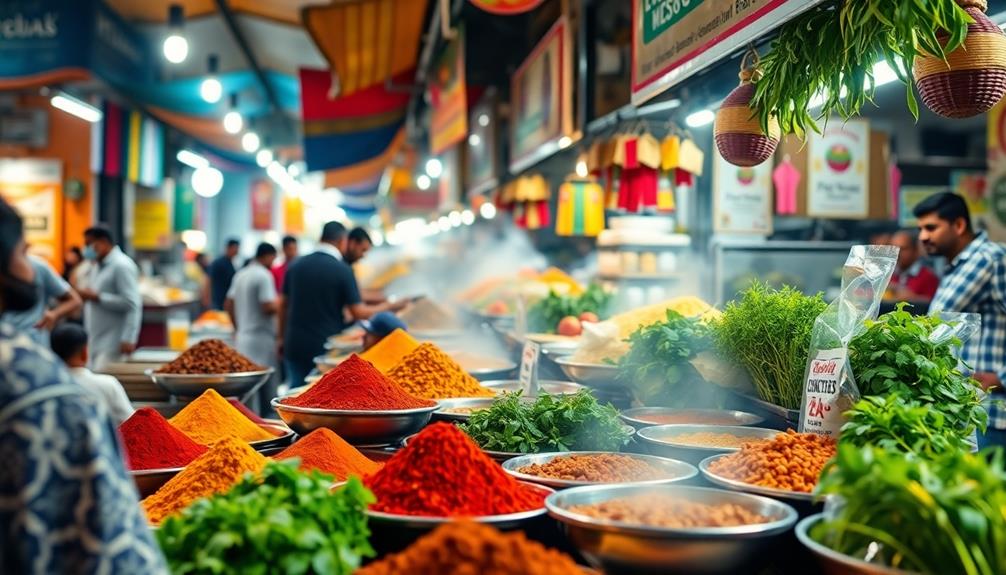
From the bustling streets of London to the vibrant markets of Dubai, the Indian diaspora has made a remarkable impact on global cuisine. By introducing traditional Indian flavors and culinary traditions, it's enriched local cuisines in various countries.
For instance, dishes like Mushroom Masala showcase how earthy flavors can be enhanced through spices, making them appealing to diverse palates. Indian expatriate chefs have led this evolution through cultural exchange, adapting traditional recipes with local ingredients to create innovative dishes like Indian-inspired sushi and curry pasta.
Indian restaurants worldwide act as cultural ambassadors, showcasing the richness of Indian culinary heritage and contributing to local economies. These establishments often feature diverse menus that blend traditional and contemporary Indian dishes, reflecting the global food movement's dynamics.
Events and festivals celebrating Indian cuisine in cities like Dubai further highlight the contributions of the Indian community, bringing together Indian flavors and local culinary practices.
Moreover, the emphasis on vegetarianism within Indian cuisine is gaining traction globally. Chefs are innovating plant-based dishes that honor traditional practices while appealing to contemporary dining trends.
This focus on sustainability not only attracts food enthusiasts but also solidifies the Indian diaspora's role in shaping fusion cuisine across the globe.
Culinary Mash-Ups Today
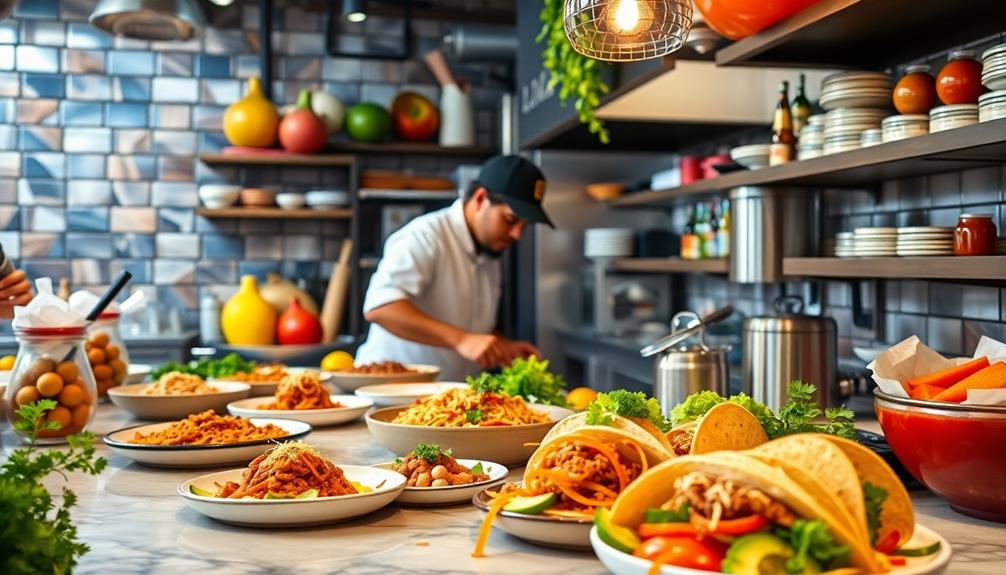
Culinary mash-ups today reflect a broader trend of blending diverse food cultures, taking inspiration from innovations like the Cronut® and ramen burgers.
These creative combinations push the boundaries of traditional cooking styles, offering bold flavors that resonate with adventurous eaters. Food trucks and Quick Service Restaurants (QSRs) are at the forefront, crafting innovative dishes that highlight local ingredients and the cultural significance of various cuisines.
Here are three notable examples of today's culinary mash-ups:
- Korean Tacos: A fusion of Korean BBQ and traditional Mexican tacos, showcasing a blend of spices and textures.
- Sushi Burritos: Wrapping sushi ingredients in a burrito format, this dish combines the best of both worlds, attracting fans of diverse culinary traditions.
- Waffle Tacos: An inventive take on breakfast, merging waffles and tacos for a sweet-savory delight.
Despite concerns about the focus on novelty over quality, these culinary creations continue to thrive, reflecting a sustained consumer interest in fusion food that celebrates a community or region's rich culinary heritage.
Future Trends in Fusion Cuisine

The future of fusion cuisine is bright, driven by a dynamic interplay of globalization and cultural exchange. As migration continues to shape culinary landscapes, you can expect chefs to create innovative fusion dishes that blend traditional culinary techniques with local ingredients.
This evolution caters to diverse palates and embraces the rise of third-culture cuisine, where dining experiences celebrate various culinary heritages.
You'll notice adventurous flavors gaining traction, with dishes like Korean-Mexican tacos and Japanese-Peruvian ceviche becoming mainstream favorites, especially among younger audiences.
Social media and food influencers play an essential role in promoting these trends, as restaurants use technology to create buzz and engage customers in unique dining experiences.
Sustainability will also shape the future of fusion cuisine, as chefs increasingly advocate for environmentally responsible cooking practices.
They'll focus on sourcing local ingredients while exploring global flavors, ensuring that their fusion dishes not only tantalize taste buds but also respect the planet.
As these trends unfold, expect a vibrant culinary landscape that reflects the rich tapestry of our interconnected world, inviting you to explore and indulge in a diverse array of flavors and experiences.
Frequently Asked Questions
What Are the Cultural Roots to Fusion Cuisine?
Fusion cuisine's cultural roots lie in centuries of trade and migration. You'll find diverse culinary practices blending together, creating innovative dishes as immigrant populations introduce their traditional flavors, reflecting a rich tapestry of shared culinary heritage.
Why Has Fusion Cuisine Become so Popular?
Fusion cuisine's like a vibrant tapestry, weaving together flavors from around the world. You've embraced this culinary trend due to globalization, adventurous palates, and social media showcasing unique dishes that tantalize and excite your taste buds.
What Is Cultural Fusion in the Field of Food?
Cultural fusion in food means blending culinary traditions from different backgrounds, creating innovative dishes that highlight unique flavors. You'll often find exciting combinations that surprise your palate, reflecting both creativity and multicultural influences in dining.
How Does Culture Influence Food?
Culture influences food by shaping your tastes, cooking methods, and ingredient choices. When you embrace new traditions, you create unique dishes that reflect your experiences, enhancing your culinary journey and connecting you to diverse communities.
Conclusion
As you explore the vibrant world of fusion cuisine, you'll see how cultural diaspora weaves together flavors like a tapestry of stories. Just as spices traveled the Silk Road, today's culinary mash-ups reflect journeys of migration and innovation. Embrace the delicious possibilities ahead, where each bite is a celebration of diversity and creativity. The future of fusion cuisine isn't just on your plate; it's a shared experience that transcends borders and unites us all.
Lifestyle
The Impact of Food Packaging Transparency on Consumer Trust
Just how much does food packaging transparency influence your trust and purchasing decisions? Discover the surprising effects that could change your shopping habits.

Transparent food packaging greatly impacts your trust in the products you buy. It allows you to see the quality and freshness at a glance, enhancing your perception of safety and overall value. Consumers like you are more likely to choose organic options and support brands that prioritize environmental sustainability. Research shows that transparent packaging not only increases your purchase intentions but also fosters a deeper loyalty to brands. With clear visuals, you feel more empowered to make informed choices about your food. There's more to uncover about how transparency shapes consumer behavior and trust, so stick around to learn further insights.
Key Takeaways
- Transparent packaging enhances consumer trust by allowing direct inspection of food quality and ingredients.
- Visual clarity boosts perceptions of product quality, particularly for organic foods.
- Consumers exhibit higher purchase intentions when they can visually assess freshness and safety.
- Aesthetic appeal in transparent packaging correlates with increased brand loyalty and satisfaction.
- Eco-conscious consumers favor brands with transparent packaging, aligning with their values of sustainability and ethical sourcing.
Importance of Transparent Packaging
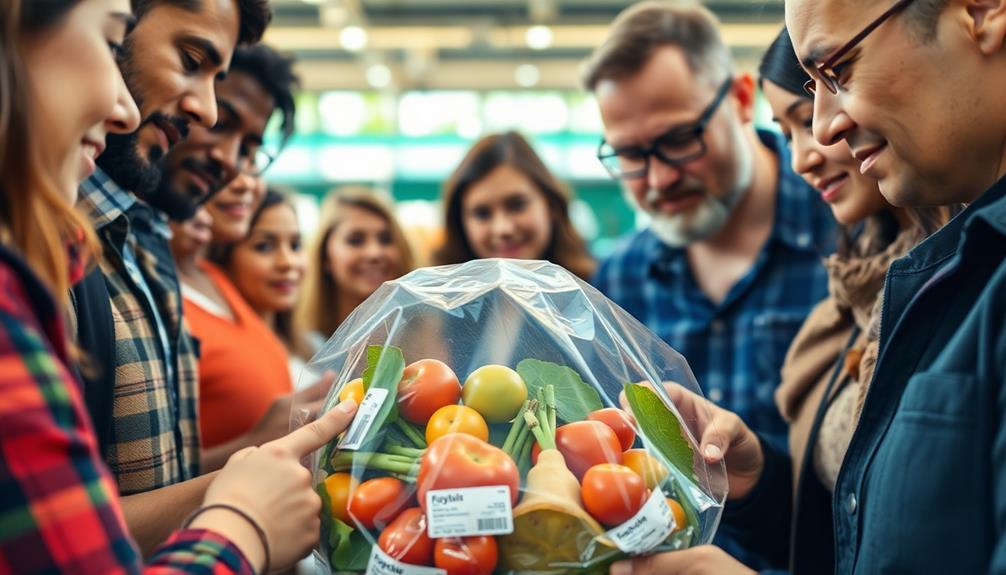
Transparent packaging plays an essential role in enhancing consumer trust and engagement with food products. When you can see what you're buying, it boosts your perception of product quality. This visual clarity allows you to assess food safety and quality easily, making it more likely that you'll choose organic food options. For instance, with Nettle and Potato Soup, the vibrant colors and fresh ingredients showcased in transparent packaging can highlight the dish's nutritional benefits.
The appeal of transparent packaging directly influences your purchase intentions, especially as you seek reliable, high-quality products.
Moreover, transparent packaging aligns with your preferences for environmental sustainability. Studies show that when you can see the product, you're more likely to feel connected to eco-friendly practices. This connection heightens your green purchasing intentions, particularly as you become increasingly aware of ecological concerns.
Clear labeling language on transparent packages reinforces your trust in the product, as it provides you with the information you need to make informed decisions.
The aesthetic appeal of transparent packaging not only satisfies your desire for visual engagement but also enhances the marketability of organic products. Ultimately, transparent packaging meets your expectations and fosters a stronger bond between you and the food you choose, driving your commitment to quality and sustainability.
Research Methodology and Findings

The impact of transparent packaging on consumer behavior has been the focus of recent research, revealing valuable insights about its effectiveness. A study involving 119 UK participants aged 18 to 58 assessed how transparent packaging influenced product evaluations across four categories, including food items like Red-Braised Pork Belly and snacks.
The findings showed that transparent packaging notably boosted purchase intentions, enhancing perceived freshness and food quality and safety. You'd likely feel a greater willingness to pay for products in transparent packages compared to opaque ones.
The empirical research demonstrated that transparency in packaging positively influenced consumer trust by increasing the perceived attractiveness and tastiness of the products. Additionally, the study accounted for aesthetic considerations, showing that visually appealing transparent packaging correlated with higher purchase intentions and overall consumer satisfaction.
Despite a minor data loss affecting a few participants, the study design proved reliable, yielding robust results across various product categories like pasta, chocolates, salmon, and granola.
These insights emphasize the critical role of transparent packaging in shaping purchasing decisions, making it an essential consideration for brands aiming to enhance consumer trust and engagement.
Effects on Consumer Behavior

When you see a product in transparent packaging, you're more likely to assess its quality visually, which can influence your buying decision.
This transparency builds trust, especially when it comes to organic foods, making you feel more confident about what you're purchasing.
Additionally, the emphasis on fresh ingredients, similar to how Brazilian cuisine showcases local produce like cassava and seafood, can further enhance this perception of quality.
Plus, if you're eco-conscious, knowing the brand cares about clear packaging can sway your choice toward greener options.
Visual Quality Assessment
Seeing food through transparent packaging can greatly influence your perception of quality and safety. When you can visually assess food quality and ingredients, it reinforces your consumer trust and increases the likelihood of choosing organic options perceived as fresher and safer.
Research shows that products in transparent packaging are often seen as more attractive and of higher quality, which makes you more willing to pay compared to those in opaque packages.
The appealing visuals in transparent packaging don't just look good; they evoke sensory responses that heighten your taste expectations and cravings. This connection to what you can see plays a significant role in your purchase decision-making.
You're likely to feel a stronger bond with products when you can monitor their freshness, enhancing your perceived food safety.
Aesthetic considerations matter too; attractive visuals in transparent packages correlate with increased purchase intentions across various product categories.
Trust Through Transparency
Transparent packaging not only enhances visual appeal but also builds consumer trust by allowing you to inspect the food's quality and ingredients directly. When you can see what you're buying, you're likely to feel more confident about its freshness and overall quality. This visual inspection reinforces your perception of the product, especially with organic food items, which often come with heightened expectations.
Research shows that transparent packaging greatly boosts your purchase intentions. You appreciate knowing the nutritional information and product attributes upfront, which helps you make informed decisions. This transparency also fosters brand loyalty, as you're more inclined to trust brands that openly communicate their offerings.
Moreover, transparent packaging isn't just about aesthetics; it aligns with your ecological concerns. Studies indicate that when you're faced with transparent packaging, you're more likely to reflect on the ecological impact of your purchase.
Consequently, the connection between transparent packaging and consumer trust becomes clear. By choosing products that showcase their quality and integrity, you're not only satisfying your immediate needs but also supporting brands that prioritize transparency and responsibility.
Eco-conscious Buying Decisions
With a growing emphasis on sustainability, eco-conscious buying decisions have become pivotal in shaping consumer behavior.
You're likely to notice how transparent packaging enhances your trust in products, especially when it comes to organic foods. This clarity allows you to assess food quality and ingredients, reinforcing your confidence in sustainability claims.
Here are three key factors influencing your eco-conscious buying choices:
- Informed Decision-Making: Transparent packaging communicates product attributes clearly, making it easier for you to choose eco-friendly options.
- Environmental Consciousness: When you see transparent packaging, it raises your awareness about the environmental impact of your purchasing choices, aligning with your values.
- Consumer Trust: As you engage with brands that value transparency, your trust in them grows, prompting you to support their sustainable initiatives.
Tourists and consumers alike are increasingly favoring products that showcase their commitment to sustainability.
This shift highlights how transparent packaging not only meets consumer expectations but also fosters lasting eco-conscious buying habits, ultimately benefiting both you and the planet.
Factors Influencing Purchase Decisions

When consumers can see the quality and ingredients of a product clearly, their trust in the brand increases substantially. Transparent packaging plays a vital role in shaping your purchase decisions. When you can easily assess freshness and safety, your confidence in the product heightens.
Research shows that when products are presented in transparent packaging, you're more likely to lean toward eco-conscious choices, particularly regarding organic food.
The aesthetic appeal of transparent packaging can't be overlooked. You likely find it more visually pleasing than opaque alternatives, which can influence your perception of product quality.
The visual cues offered by clear packaging—like vibrant colors and textures—effectively communicate attributes that enhance your expectations for taste and quality.
Additionally, your ecological concerns and connection to nature are positively impacted by transparent packaging, which can drive your intent to purchase sustainable products.
By choosing brands that prioritize transparency, you not only support your own values but also foster a market that prioritizes sustainability and quality.
Ultimately, the clarity offered by transparent packaging builds consumer trust and shapes your purchase decisions in significant ways.
Visual Appeal and Trust

The visual appeal of packaging greatly shapes your trust in a product. When you see transparent packaging, it not only allows you to assess food quality but also enhances your perception of freshness and safety.
Here are three significant ways visual appeal impacts your consumer trust:
- Aesthetic Appeal: Attractive packaging design captures your attention, making the product more desirable. Transparent materials often convey a sense of honesty, boosting your willingness to pay more.
- Enhanced Purchase Intentions: When you can see the product inside, it reinforces your belief in its authenticity. This transparency often translates into higher purchase intentions, especially for organic foods.
- Stronger Sensory Responses: The visual clarity of transparent packaging can trigger feelings of hunger or cravings, positively influencing your consumer evaluations. You're likely to associate visible quality with better taste and freshness.
Ultimately, transparent packaging plays an essential role in shaping your trust in food products. If the contents match your expectations, your confidence in the brand strengthens, leading to loyalty and repeat purchases.
Implications for Retail Strategies
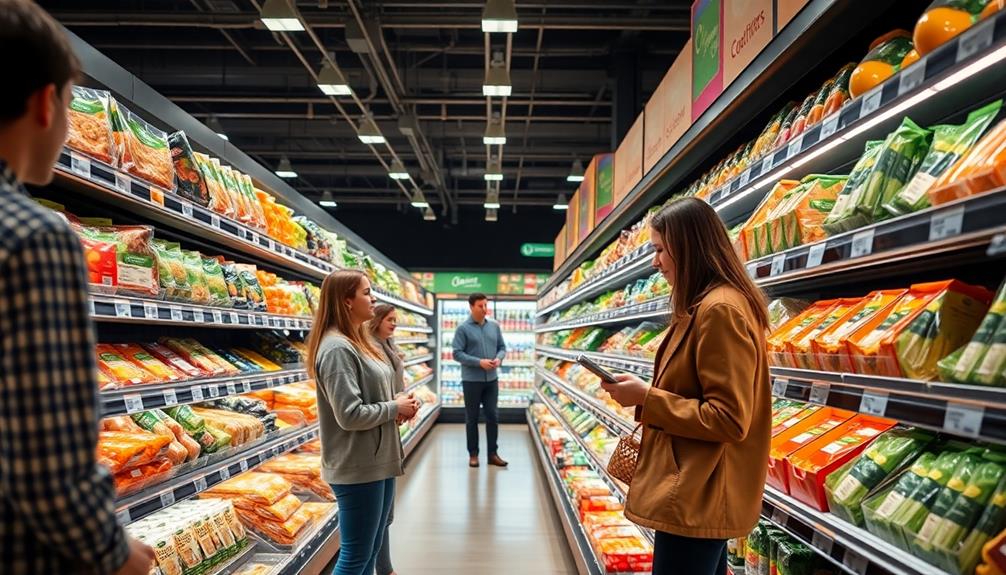
Retail strategies need to adapt to the growing consumer preference for transparent packaging, as studies show that 65% of shoppers are more likely to choose products that allow them to see what's inside.
By embracing transparent packaging, you can greatly enhance consumer trust and boost purchase intentions, particularly for organic and sustainably sourced products. Customers today aren't only concerned about food quality but also about product origins and ethical practices.
Incorporating transparent packaging into your retail strategies aligns with this ecological concern, appealing to those who value sustainability.
The visual clarity of these packages allows consumers to assess freshness and quality directly, reinforcing their trust in your brand.
Furthermore, aesthetically pleasing transparent packaging is more engaging than opaque alternatives, improving the marketability of your products in crowded retail spaces.
By providing clear insights into what's inside, you foster a connection with shoppers that encourages loyalty and repeat purchases.
Ultimately, adapting your retail strategies to include transparent packaging can set you apart in a competitive market, catering to the evolving preferences of conscious consumers.
Frequently Asked Questions
Why Is Transparency Important in Food Packaging?
Transparency in food packaging matters because it allows you to see the quality and ingredients of what you're buying. It helps you make informed choices, fostering trust and confidence in the products you consume.
How Does Food Packaging Affect the Consumer?
Food packaging affects you by influencing your perceptions of quality and freshness. When you see appealing designs or clear labels, you're more likely to trust the product, making you feel confident in your purchase decisions.
Why Is Transparency and Trust Important to Consumers?
You know the saying, "Honesty is the best policy." Transparency and trust matter to you because they empower informed choices, boost your confidence in products, and nurture a deeper connection with brands that value your health and safety.
How Does Packaging Affect Consumer Satisfaction?
Packaging greatly affects your satisfaction by influencing your perception of a product's freshness and quality. When you see appealing, transparent packaging, you're more likely to feel compelled to buy and enjoy the product.
Conclusion
To sum up, transparent food packaging greatly boosts consumer trust, with 73% of shoppers more likely to purchase products with clear ingredient listings. When you see what's inside, you're not just buying a product; you're investing in a brand that values honesty. This transparency shapes your choices and loyalty, leading retailers to rethink their strategies. By prioritizing openness, brands can create lasting connections with you, fostering a sense of confidence in every purchase you make.
-

 Vetted5 months ago
Vetted5 months ago14 Best Personalized Father's Day Gifts for Your Husband – Show Him You Care
-

 Alfresco5 months ago
Alfresco5 months agoAlfresco Stacker Doors: Seamless Indoor-Outdoor Living!
-

 Vetted6 months ago
Vetted6 months ago15 Best EMS Foot Massagers for Neuropathy to Soothe Your Feet
-

 Craft and Textiles7 months ago
Craft and Textiles7 months ago15 Best Places to Buy Appliances for Your Home – Top Retailers Reviewed
-

 Vetted5 months ago
Vetted5 months agoBattle Born Batteries Review: Reliable Power Solution
-

 Vetted5 months ago
Vetted5 months agoD-Link Switch Review: Lite Layer 3 Managed Networking
-

 Tableware and Dining Accessories7 months ago
Tableware and Dining Accessories7 months agoWhat Is the Meaning of the Word Tableware
-

 Tableware and Dining Accessories7 months ago
Tableware and Dining Accessories7 months agoWhat Is the Hindi Meaning of Tableware





























